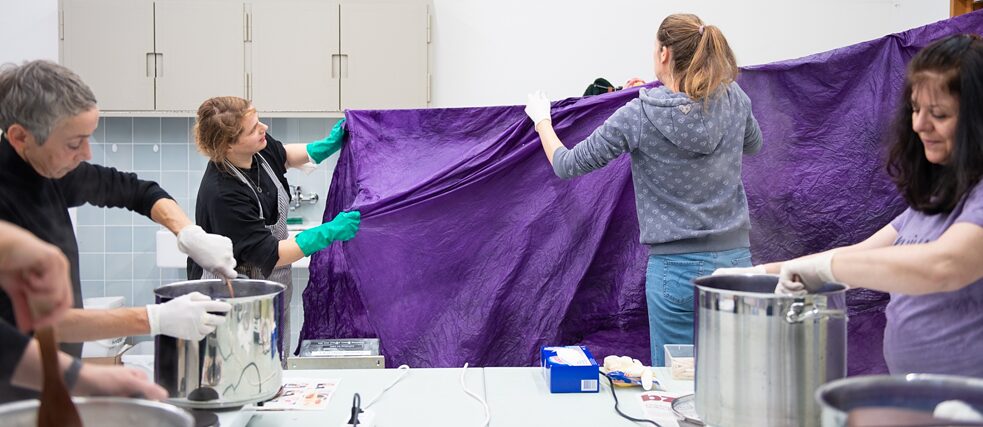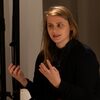Ruth Buchanan

The Goethe-Institut New Zealand and Contemporary HUM present a series of portraits about New Zealand artists who have found a new home - also artistically - in Germany. Curator Maja Wismer has been working with artist Ruth Buchanan on her latest exhibition in Basel.
By Maja Wismer
Our invitation to Aotearoa New Zealand artist Ruth Buchanan to exhibit in the Kunstmuseum Basel (Basel art museum) was based on her reputation as an artist who takes a truly comprehensive approach to her work, and who over the last ten years has built a profile internationally in the intersecting space between design and curating methods as artistic forms of expression.
Ruth Buchanan has realised a number of major projects, including at the Tate Modern, London and at the Gwangju Biennale in Gwangju, the MASP São Paulo, the Badischer Kunstverein in Karlsruhe, the Kröller-Müller Museum in Otterlo, the Hamburger Bahnhof in Berlin, and the Adam Art Gallery Te Pataka Toi in Te Whanganui-a-Tara Wellington. In 2019, she created a major exhibition in the form of a “performance” of the collection of the Govett-Brewster Art Gallery museum for contemporary art in Ngāmotu New Plymouth, Aotearoa New Zealand. Along with her exhibition activities, she has published on a regular basis, most recently Where does my body belong? From institutional critique to infrastructural transformation Or Standards and Mothers with Artspeak, Vancouver, and the website Evacuation Tapes that responds to the work of Aotearoa New Zealand poet J.C. Sturm. Ruth Buchanan also teaches as a guest lecturer at a number of tertiary institutions. In 2018 she was awarded the prestigious Walters Prize in Aotearoa New Zealand.
Ruth Buchanan’s preferred artistic form has become the exhibition format, with its ability to provide a spatial experience of both content associations and histories. Her artistic input extends to the texts posted on the walls and exhibition leaflets as well as the selection, hanging and dramaturgy of the works taken from Basel's public collection of contemporary art, through a scenographic palette of wall colours, screens, vitrines, seating and audio. Such components, normally regarded as 'tools', and under the art world’s tacit agreement on the ostensibly neutralising 'white cube' aesthetic, subordinated to the exhibits as such, now lead a dual existence in the exhibition space. For Ruth Buchanan, they are both resources supporting the exhibited works (as a guidance system) and objects exhibited in their own right. This dual existence challenges museum categories, just as we are challenged by the multiple roles of Ruth Buchanan as an artist.
I have been the head of the Kunstmuseum Basel | Gegenwart ( Basel art museum | contemporary art) since the autumn of 2020. This building forms part of the Kunstmuseum Basel, and since it opened it has established an international reputation as one of Europe’s leading museums for contemporary art. The last two years have been a time of massive growth in the museum sector, in response to Black Lives Matter and #MeToo, and to many of the injustices that have been uncovered in the recent paradigm shift, with noticeable further momentum from the pandemic. This new awareness is highly encouraging. Now, more than forty years since the museum building was opened, I believed it was time to interrogate some established patterns and practices, and bring them into the public gaze. Ruth and I both had the feeling that this was the ideal moment to start firming up our ideas of what “the contemporary” might signify in art and in some wider socio-political contexts.
At the core of Ruth’s work is her interest in the spatial/political dimension of organisation systems. To date much of her reflection in this area has remained on the linguistic level, with little opportunity to explore this articulated dynamic rethinking of the physical space of museums, as an implicated social domain.
The result of the work Ruth has undertaken for Kunstmuseum Basel is an exhibition that takes in the entire building, entitled “Heute Nacht geträumt [Dreamt last night] – an exhibition by Ruth Buchanan” (19.03-14.08.2022). Ruth structures the exhibition around colours, materials, texts and structural elements inserted and integrated into the existing spaces, and above all with numerous works from the Kunstmuseum Basel collection.
At the heart of the exhibition are four questions: From what point does the contemporary begin? Which documents say what? Where does my body belong? Will I come back? These questions were formulated in a dialogue between Ruth, my curatorial colleague Len Schaller and myself. They underpin the exhibition as wall paintings extending over all four floors of the building, giving the exhibition form, and embodying the imperative to rethink possible paradigms for the ways museums could operate today. These questions invite museum visitors to start a conversation on how they experience museums in general, and a visit to the Kunstmuseum Basel | Gegenwart in particular.
These are open questions, which can also be applied to many other situations and locations we experience in our everyday lives – visiting a friend, interacting with our children’s school, or travelling on public transport. So as well as operating as structuring components for the exhibition, they are also offered as “takeaways”, inviting visitors to continue this conversation in the wider world. It is my hope that after the physical components of the exhibition have been taken down, the shadows of the questions that Ruth has materialised as violet wall paintings will remain a perceptible presence for the coming years of my time as head of the Kunstmuseum Basel | Gegenwart.
![Detail of Ruth Buchanan’s work 'Enclosure' (When the sick rule the world, reverb), 2019/22, during the construction of the exhibition “Heute Nacht geträumt [Dreamt last night]. An exhibition by Ruth Buchanan”, in Kunstmuseum Basel | Gegenwart.](/resources/files/jpg1328/titel-mit-screen-formatkey-jpg-w983.jpg)





